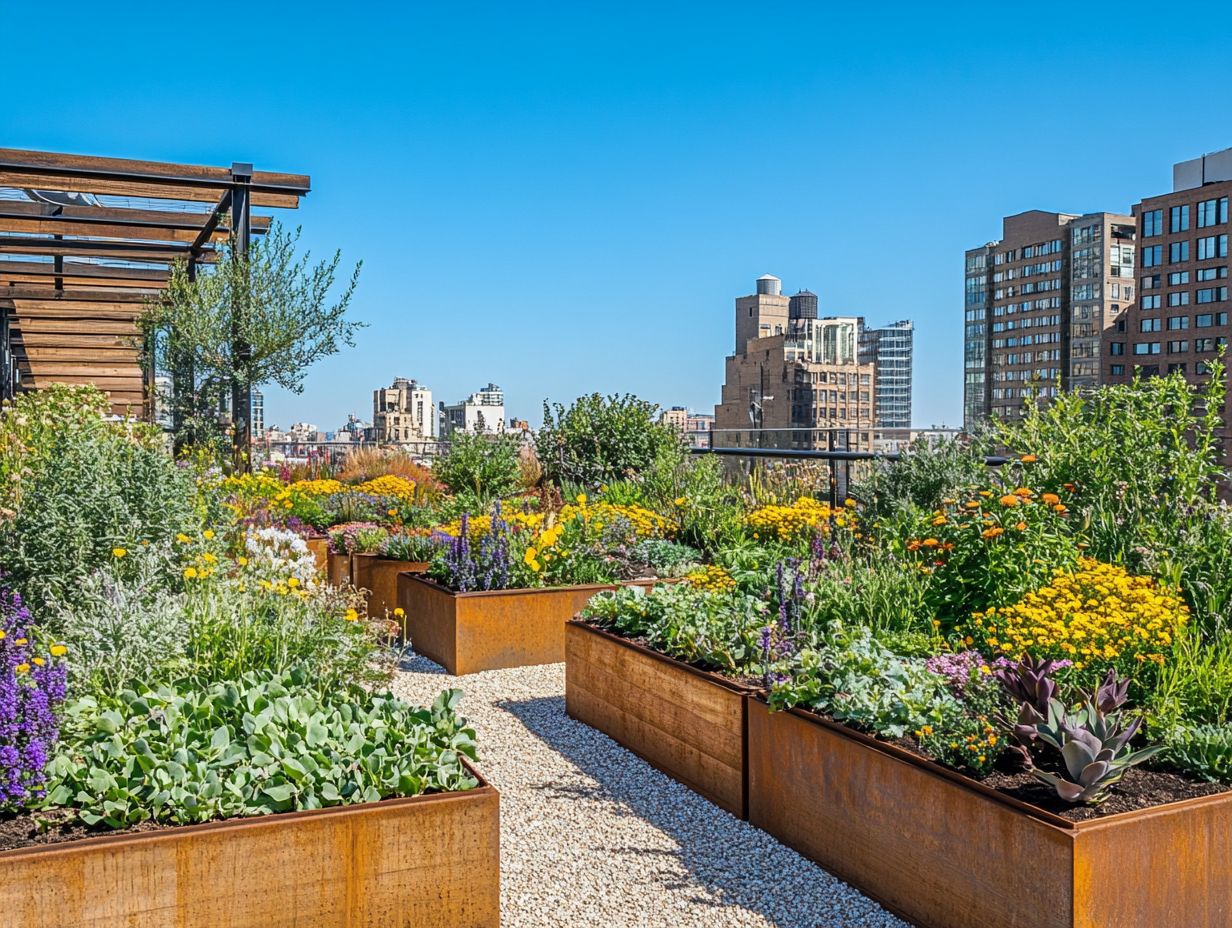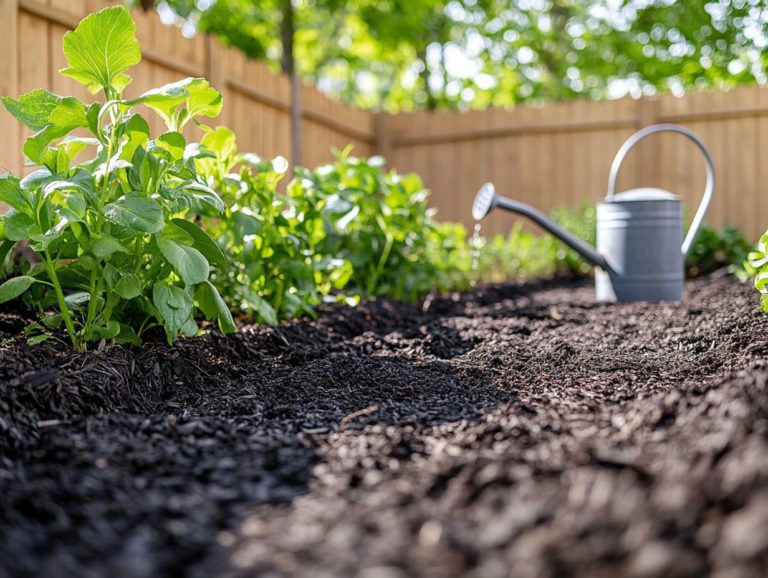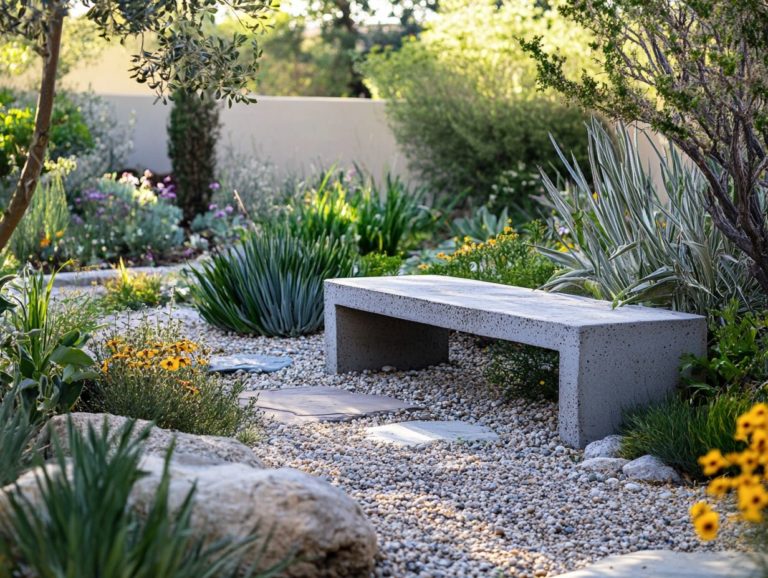Creating a Drought-Resistant Roof Garden
In a world where climate change and urbanization put pressure on our green spaces, a drought-resistant roof garden stands out as a remarkable sustainable solution.
This exploration delves into these innovative gardens, showcasing both their environmental and economic advantages. You’ll learn how to choose the right plants, design your rooftop oasis, and maintain it efficiently while using minimal water.
We ll also tackle common challenges that may arise, ensuring your garden flourishes, even in the driest conditions. Together, you can cultivate a greener, more resilient urban landscape.
Contents
- Key Takeaways:
- Benefits of a Drought-Resistant Roof Garden
- Choosing the Right Plants
- Designing and Building a Drought-Resistant Roof Garden
- Maintaining a Drought-Resistant Roof Garden
- Troubleshooting Common Issues
- Frequently Asked Questions
- Why should I create a drought-resistant roof garden?
- What techniques can I use for a drought-resistant roof garden?
- What are some examples of drought-resistant plants?
- Are there any limitations to creating a drought-resistant roof garden?
- Can I create a drought-resistant roof garden in any climate?
Key Takeaways:

- Designing a drought-resistant roof garden not only benefits the environment but also saves money in the long run.
- Choose native plants that are drought-tolerant and have low water requirements to ensure a successful and thriving roof garden.
- Maintain your drought-resistant roof garden by using efficient watering and fertilization strategies while promptly addressing any issues that may arise.
What is a Drought-Resistant Roof Garden?
A drought-resistant roof garden is a modern method of sustainable urban living, designed to thrive in arid conditions while significantly enhancing environmental sustainability. By embracing a green roof system, these gardens soften the impacts of climate change and play a pivotal role in growing food in cities. For more insights, learn how to create a drought-resistant oasis, providing a crucial solution for food production in densely populated areas.
These roof gardens are thoughtfully designed with layered systems that facilitate effective water retention and drainage. This design ensures that even during dry spells, the selected plants can flourish beautifully. By incorporating a diverse array of drought-tolerant plants, such as succulents and native perennials, you can enjoy a vibrant garden. For insights on design, check out this guide on how to plan a drought-resistant garden layout that requires minimal irrigation.
The strategic selection of these plants not only helps mitigate the urban heat island effect but also fosters local biodiversity, attracting beneficial insects and birds to your space. Integrating such gardens elevates environmental sustainability by reducing cooling energy costs and improving air quality, thus providing a multitude of ecological benefits to urban settings.
Benefits of a Drought-Resistant Roof Garden
Drought-resistant roof gardens present a wealth of benefits that significantly enhance both environmental and economic sustainability, making them an enticing option for homeowners and city planners alike.
These verdant roofs play a crucial role in stormwater management, effectively reducing runoff and alleviating flooding in urban landscapes. They also provide great insulation, helping to lower energy costs by maintaining comfortable indoor temperatures.
Additionally, these gardens provide important homes for wildlife, promoting biodiversity and enriching the ecological footprint of cityscapes.
Environmental and Economic Advantages
The environmental and economic benefits of integrating drought-resistant roof gardens are truly remarkable. Not only do they elevate the aesthetic appeal of urban landscapes, but they also foster environmental sustainability and enhance energy efficiency.
By helping to mitigate the urban heat island effect and reducing energy costs through natural insulation, these gardens become essential allies in your quest for a greener city. They also open the door to urban agriculture, enabling food cultivation right in the heart of your community. This dual functionality highlights the significance of such green initiatives in a climate-conscious era.
These exciting gardens are vital havens for many species, supporting local biodiversity and bolstering ecosystem resilience. By capturing rainwater, they effectively reduce stormwater runoff, translating into considerable savings for municipalities on drainage systems while safeguarding waterways from pollution.
The impact on local food networks is profound; urban residents gain access to fresh produce, fostering healthier eating habits while cutting down on the carbon footprint linked to long-distance food transport. Together, these features establish drought-resistant roof gardens as critical components in the shift toward more sustainable urban environments.
Choosing the Right Plants

Choosing the right plants is crucial for creating a thriving drought-resistant roof garden. The plants you select will directly influence the garden’s resilience, sustainability, and visual appeal. For an even more effective design, consider designing a drought-resistant patio alongside your garden. Focus on drought-tolerant species suited to your local climate.
Consider sedum species; they are hardy and flourish in shallow soil, making them excellent candidates for green roofs. They enhance the beauty of your garden and contribute significantly to environmental benefits, such as stormwater absorption and providing habitat for wildlife.
Criteria for Drought-Resistant Plants
When selecting plants for your drought-resistant roof garden, consider critical factors like drought tolerance, soil depth requirements, and maintenance schedules. Drought-tolerant plants thrive in arid conditions, requiring significantly less water and care than traditional garden plants.
Understand the available soil depth in your roof garden, as this will determine the viability of your plant choices and their long-term growth potential. A well-planned maintenance schedule is key to sustaining the health and beauty of your green oasis.
Assess how well your plants can adapt to local climate conditions for the best results! Some species flourish better in specific environments than others. Shallow-rooted plants may need minimal layers for successful establishment, while deeper-rooted varieties require a more substantial substrate to thrive.
Your maintenance schedule should include regular checks on soil moisture levels, timely pruning, and fertilization to keep your plants robust. By making informed choices, you enhance the aesthetics of your garden and bolster its resilience against drought.
Designing and Building a Drought-Resistant Roof Garden
Designing and building a drought-resistant roof garden requires a thoughtful approach. Your journey starts with a detailed garden design that considers the necessary structural support for the weight of soil and plants, especially when creating a drought-resistant vegetable garden.
Crafting a layout is essential for ensuring your garden thrives from the start. It s important to promote efficient water use while highlighting drought-tolerant plants.
Align your plans with local building codes and regulations to ensure a smooth installation process that yields impressive results.
Key Considerations and Techniques
Key considerations and techniques are essential for successfully establishing your drought-resistant roof garden. For guidance on planning, including factors like drainage, soil mix, and plant spacing, check out how to create a drought-resistant garden to create optimal growth conditions for your garden.
Establishing a regular maintenance schedule is vital for monitoring plant health and managing pests. Choosing native plants that thrive in arid conditions can dramatically enhance your water efficiency.
Understanding the specific sunlight exposure and wind patterns unique to your rooftop allows you to thoughtfully place your vegetation, maximizing both aesthetic appeal and ecological function.
Incorporating mulch helps retain moisture in the soil while minimizing weed growth. Implementing a drip irrigation system, a water-saving system that delivers water directly to plant roots, ensures your plants receive adequate hydration without waste.
Regular evaluations allow you to identify any emerging issues, ensuring your garden flourishes and continues to deliver its many benefits.
Maintaining a Drought-Resistant Roof Garden

Maintaining a drought-resistant roof garden is vital for its longevity and effectiveness in helping cities become more sustainable. Establishing a consistent maintenance schedule that incorporates strategic watering and fertilization is essential for the health of your plants.
While drought-resistant plants typically require less frequent watering, it’s important to understand the specific needs of each species. This knowledge will ensure optimal growth and vitality, and for those looking to enhance their gardening skills, exploring how to design a drought-tolerant garden can further enhance the aesthetic appeal and functional contributions of your roof garden to the urban ecosystem.
Watering and Fertilization Strategies
Effective watering and fertilization strategies are essential for maintaining a drought-resistant roof garden. They play a pivotal role in ensuring plant health and garden sustainability.
To optimize your watering regimen, establish a routine tailored to the specific needs of your drought-tolerant plants. This way, they receive just the right amount of moisture without the risk of overwatering.
Embracing organic fertilization techniques can enhance soil health and encourage vigorous growth while adhering to a maintenance schedule that conserves resources.
Understanding the specific conditions on your rooftop can further refine these practices. For instance, drip irrigation systems deliver water directly to the roots of plants, minimizing waste and promoting deep root development.
Incorporating compost and natural fertilizers nourishes your plants and improves soil structure, enhancing water retention. These thoughtful approaches foster a thriving ecosystem right above the bustling city, showcasing how sustainability and aesthetic appeal can beautifully coexist.
Troubleshooting Common Issues
Troubleshooting common issues in your roof garden is crucial for maintaining plant health and fostering a thriving ecosystem in an urban environment. By effectively identifying and addressing challenges like pest infestations, nutrient deficiencies, or inadequate drainage, you can uphold the principles of sustainable gardening.
Regular monitoring and sticking to a maintenance schedule will significantly enhance your ability to detect and intervene early, ensuring the longevity and resilience of your plants.
Identifying and Addressing Problems
Identifying and addressing problems in your garden demands a keen eye and a solid understanding of common issues. Use your problem-solving skills to keep your garden thriving!
From spotting signs of overwatering or underwatering to diagnosing pest infestations and nutrient deficiencies, being proactive is key. By employing effective strategies and tapping into the right resources, you can ensure your garden continues to flourish amidst the urban landscape.
Being aware of environmental factors like wind exposure, sunlight intensity, and soil composition significantly influences the overall health of your garden. Educating yourself about drought-tolerant species and their specific care requirements will help you anticipate potential challenges.
Regular monitoring practices, such as keeping an eye out for unusual growth patterns or checking soil moisture levels, can lead to the early detection of issues. Start monitoring your garden today to ensure its health!
Incorporating water-efficient irrigation systems and mulch will further enhance your garden’s resilience. Stay informed and actively engaged in sustainable practices to nurture not just your plants, but also the broader ecological balance that supports them.
Frequently Asked Questions

What is a drought-resistant roof garden?
A drought-resistant roof garden is a type of garden specifically designed to thrive in dry and hot conditions. By creating a wildlife-friendly drought garden, you can use techniques and plants that require little to no irrigation. This type of garden is ideal for areas that experience frequent droughts or have limited access to water.
Why should I create a drought-resistant roof garden?
Creating a drought-resistant roof garden offers numerous benefits. It reduces water usage and costs, improves the energy efficiency of your building, and provides a beautiful space for relaxation or growing food. For more insights, consider establishing a drought-tolerant garden.
It also helps reduce drought’s impact on the environment.
What techniques can I use for a drought-resistant roof garden?
Start with selecting plants that thrive in low-water conditions. Here are some effective techniques:
- Use plants that need little water.
- Incorporate mulch and compost to retain moisture.
- Install efficient irrigation systems, like drip irrigation, which delivers water directly to the roots of plants.
- Design the garden to maximize shade and minimize water loss.
What are some examples of drought-resistant plants?
Some examples of drought-resistant plants include:
- Succulents
- Cacti
- Lavender
- Rosemary
- Yarrow
- Sedum
These amazing plants store water in their leaves, making them perfect for dry conditions. They require minimal watering.
Are there any limitations to creating a drought-resistant roof garden?
Drought-resistant roof gardens are beneficial and easy to maintain, but there are limitations. For those interested in creating a drought-tolerant landscape, consider the weight of your roof, sunlight exposure, and possible water runoff before starting.
Can I create a drought-resistant roof garden in any climate?
While drought-resistant roof gardens are ideal for dry and hot climates, they can also be created in other climates with proper planning and care. To learn more about this process, check out how to plan a drought-resistant community garden. In cooler or humid climates, choosing the right plants and incorporating efficient irrigation and mulching techniques can lead to success.
Start planning your drought-resistant roof garden today and transform your space!






